
Art Nouveau is an international style of art, architecture and applied art, especially the decorative arts, that was most popular between 1890 and 1910. A reaction to the academic art of the 19th century, it was inspired by natural forms and structures, particularly the curved lines of plants and flowers.

Moros y Cristianos or Moros i Cristians literally in English Moors and Christians, is a set of festival activities which are celebrated in many towns and cities of Spain, mainly in the southern Valencian Community. According to popular tradition the festivals commemorate the battles, combats and fights between Moors and Christians during the period known as Reconquista. There are also festivals of Moros y Cristianos in Spanish America.

Colonia Roma, also called La Roma or simply, Roma, is a district located in the Cuauhtémoc borough of Mexico City just west of the city’s historic center, and in fact is no longer a single colonia (neighbourhood) but now two officially defined ones, Roma Norte and Roma Sur, divided by Coahuila street.

Plaza del Mercado de Ponce or, formally, Plaza del Mercado Isabel Segunda, is a historic marketplace building in Ponce, Puerto Rico. It was inaugurated in 1863 by Ponce Mayor Don Luis de Quixano. The building was designed by famed engineer Timoteo Luberza. The Plaza occupies a city block in the Ponce Historic Zone at the grid formed by Calle Atocha, Estrella, Leon, and Castillo streets. It has room for 65 kiosks. It was originally called "Plaza del Capá."

Alcoy or Alcoi is an industrial and university city, region and municipality located in the province of Alicante, Spain. The Serpis river crosses the municipal boundary of Alcoi. The local authority reported a population of 59,526 residents in 2010.

The Ponce Municipal Library, formally, Biblioteca Municipal Mariana Suárez de Longo, and also known as Biblioteca Publica de Ponce, is the library system of the municipality of Ponce, Puerto Rico. Founded in 1870, it is the oldest public library in Puerto Rico. The system has its main library on Miguel Pou Boulevard, in barrio San Antón, in the city of Ponce, and seven satellite library branches, three in the city's urban area and four spread out in the municipality's rural areas. The main library inaugurated a new building on Bulevar Miguel Pou in August 2007, where the former Puerto Rico District Court building was located.
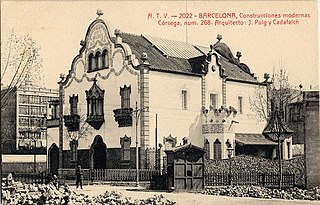
Casa Trinxet was a building designed by the Catalan Modernisme architect Josep Puig i Cadafalch and built during the years 1902–1904, officially considered completed in 1904. It was located at the crossroads of Carrer Balmes and Carrer del Consell de Cent, in the Eixample district of Barcelona, Catalonia, Spain. Casa Trinxet was "one of the jewels of Barcelona Modernisme" and one of the buildings of Barcelona's Illa de la Discòrdia, because of competing attitudes among Domènech i Montaner, Puig i Cadafalch and Antoni Gaudí.
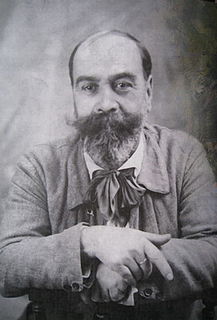
Joaquin Mir Trinxet or Joaquin Mir y Trinxet was a Spanish artist known for his use of color in his paintings. He lived through a turbulent time in the history of his native Barcelona. His paintings helped to define the Catalan art movement known as modernisme.
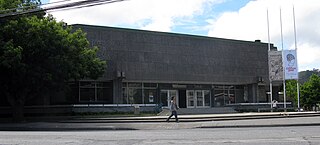
The Casa del Arte José Clemente Orozco is a Chilean art museum on the campus of the University of Concepción, in Concepción. It is situated on the corner of Chacabuco and Larenas, facing the Plaza Perú. The gallery attracts approximately 75,000 visitors a year and houses the country's largest collection of paintings outside the capital city of Santiago, and the most complete collection of Chilean art with some 1,800 works. One of its main features is the mural Presencia de América Latina (1964) by the Mexican artist Jorge González Camarena, which is in the entrance hall.
Vicente Pascual Pastor was a spanish architect, one of the main architects of the Art Nouveau in Alcoy and the Valencian Art Nouveau.

Art Nouveau in Alcoy,, as one of the main focus of the Valencian Art Nouveau, is the historiographic denomination given to an art and literature movement associated with the Art Nouveau in Alcoy (Alicante), Valencian Community, in Spain.
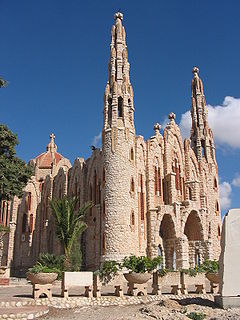
Valencian Art Nouveau, is the historiographic denomination given to an art and literature movement associated with the Art Nouveau in the Valencian Community, in Spain.

The Casa del Pavo(Turkey's House) is a private building at 15 Sant Nicolau Street, in the city center of Alcoy (Alicante), Valencian Community, Spain. It is one of the main works of the Art Nouveau in Alcoy.

The Circulo Industrial de Alcoy(Alcoy's Industrial Circle) is a cultural institution from Alcoy (Alicante), Valencian Community,Spain, founded on January 1, 1868. It is placed at 19 Sant Nicolau street,in the city center of Alcoy.

The Casa d'Escaló(Escaló house) is a public building at 2 Joan Cantó street, in the city center of Alcoy (Alicante), Valencian Community, Spain. It is one of the main works of the Art Nouveau in Alcoy.
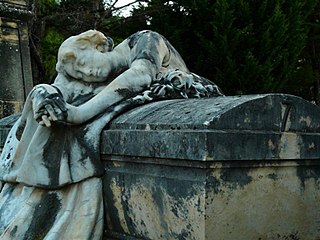
The Cementerio de San Antonio Abad(English: Saint Anthony Cemetery) is a cemetery located in Alcoy (Alicante), Spain.

The Casa Vilaplana(Vilaplana house) is a private building at 8 Joan Cantó street in the city center of Alcoy (Alicante), Valencian Community, Spain.
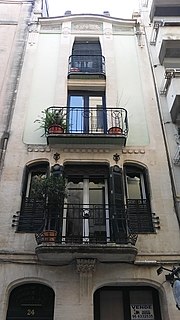
The Casa Briet(Briet house) is a private building at 24 Sant Josep Street, in the city center of Alcoy (Alicante), Valencian Community, Spain.





















